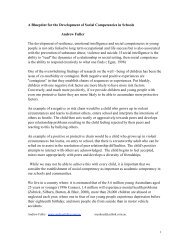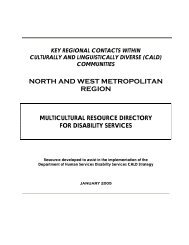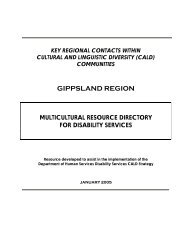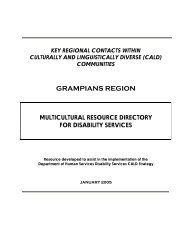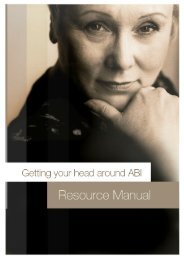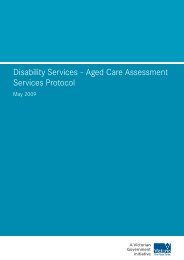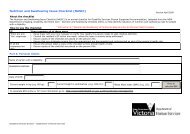Positive Behaviour Support - Department of Human Services - Vic ...
Positive Behaviour Support - Department of Human Services - Vic ...
Positive Behaviour Support - Department of Human Services - Vic ...
You also want an ePaper? Increase the reach of your titles
YUMPU automatically turns print PDFs into web optimized ePapers that Google loves.
26 <strong>Positive</strong> behaviour support: Getting it right from the start - Facilitators reference manual<br />
PowerPoint 39*<br />
There are four types <strong>of</strong> attachment styles which include:<br />
1. Secure (usually confident)<br />
and three other insecure attachment styles<br />
2. Avoidant (dismissing)<br />
Here the person may think positively about themselves but have a negative view <strong>of</strong> the world<br />
and may avoid social interactions. They may have a tendency to avoid seeking help and do not<br />
like strong, emotionally-involved relationships.<br />
PowerPoint 40*<br />
3. Anxious (ambivalent/preoccupied/resistant)<br />
Here the person may think negatively about themselves and think other people are good. They<br />
lack confidence in their own abilities and <strong>of</strong>ten prefer for others to make decisions for them.<br />
4. Disorganised (Fearful/disorientated/unresolved)<br />
Here the person may have a negative view <strong>of</strong> themselves and others, low confidence, fear <strong>of</strong><br />
being rejected by others and are unable to adequately express how they are feeling.<br />
People with an insecure attachment style, may exhibit a range <strong>of</strong> behaviours <strong>of</strong> concern including<br />
problematic ways <strong>of</strong> interacting with those around them. It is important to remember that they<br />
have developed a traumatic belief about themselves, other people and their environment, which<br />
influences their relationships, feelings and interactions and <strong>of</strong>ten are not aware <strong>of</strong> why they feel<br />
or act the way they do.<br />
How does trauma impact on attachment?<br />
A traumatic event can affect a person’s ability to cope with stress and makes them feel<br />
overwhelmed. Sometimes the effects are delayed by weeks and in some cases even years.<br />
Often people with an intellectual disability may not be able to fully understand why something<br />
has happened the consequences for themselves and others, how to problem solve or know<br />
what coping strategies to use. As a result people with an intellectual disability are more likely to<br />
show behaviours <strong>of</strong> concern when they feel that their personal safety is threatened.<br />
Case study<br />
Terry was physically abused when he was a child and now he gets scared if he hears<br />
someone yelling. Terry may misread the person’s tone <strong>of</strong> voice and body language as a<br />
potential threat and become fearful. He might suddenly lash out aggressively as part <strong>of</strong> an<br />
automatic response to keep himself safe.<br />
In groups identify some potential strategies that you could put into place to support a person<br />
with an intellectual disability to establish positive relationships with others.<br />
Why do you think these might work?<br />
It is important to note that not all people who have experienced trauma will go onto develop<br />
significant attachment problems. Generally people who are social, confident, have effective<br />
communication skills and strong relationships with others are better able to cope with<br />
trauma.



